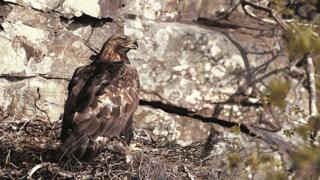
Image copyright
Chris Gomersall (rspb-images.com
Golden eagles have bred at a “rewilding” estate in the Scottish Highlands for the first time in 40 years.
An eagle pair successfully reared the chick at an artificial eyrie on the 10,000-acre Dundreggan estate.
This positive news came as it emerged that a young tagged gold eagle known as Tom has gone missing in the Strathbraan area of Perthshire.
Tom was being satellite-tracked by wildlife charity Raptor Persecution UK.
Springwatch presenter Chris Packham has been working with the charity on the tagging project
On the Dundreggan estate an artificial nest was built five years ago high on a rocky crag, on the remains of an old nest site.
Its purpose was to encourage a pair of golden eagles to mate. It was made using branches from the native pines and birch trees that cover the mountain slopes.
Doug Gilbert is the manager of the estate. He has been checking the eyrie every spring for the last five years. He described it as a “rewilding successes story beyond our wildest dreams”.
He told the BBC: “I feel elated. Absolutely amazing. To have done a little bit of management, and to have a wild bird decide it’s a good place to be, and produce a chick, then it’s wonderful.”
Mr Gilbert said the “rewilding” approach adopted at Dundreggan had helped. The estate used to be managed for deer stalking, and the animals tend to graze on tender saplings before they can become mature.
Now the deer population has been reduced to a level where trees can grow again. “Golden eagle-friendly” mountaintop forests have been replanted, containing tough, waist-high “wee trees”, such as dwarf birch and downy willow.
Image copyright
Trees for Life
There has been a recorded increase in black grouse, which is an important food source for golden eagles.
However Mr Gilbert said: “I do worry for the safety of the chick. They are renowned for wandering quite far distances. There are several black spots where eagles regularly disappear. Some of them are well within range of a young golden eagle – just 50 km away, and chicks can travel for 100-150km.”
The Monadhliath mountains – one of these “blackspots” – is just a short flight across Loch Ness for the chick.
“What we are doing here won’t change the course of history,” said Mr Gilbert. “But if we can produce one chick, rather than one being killed somewhere else, then it’s a good thing.”
Around 120 miles south, in the Strathbraan area of the Perthshire uplands, the young tagged golden eagle known as Tom has been reported missing. Tom was hatched in Argyll in May 2019.
Four of the eagles that were tagged by Raptor Persecution UK (RPUK) in 2017 have since disappeared.
Police Scotland confirmed they have carried out enquiries regarding the missing golden eagle. They said no criminality had so far been established, but are appealing for information.
It’s unclear what has happened to Tom. While some claim that its tag could simply have stopped working, golden eagles do face persecution.
A number of grouse shooting estates are located in the Strathbraan region. According to the RSPB, Tom is now the sixth golden eagle to have disappeared in this area since 2014.
Image copyright
Raptor Persecution UK
A video published by Chris Packham on Twitter highlighting Tom’s case has so far had almost 300,000 views. He said: “We have no proof as to what happened, apart from that the tag, which had a full battery, and was transmitting consistently, failed catastrophically.
A report by Scottish Natural Heritage (SNH) in 2017 concluded that a third of satellite-tagged golden eagles had disappeared suspiciously. It found that 41 of 131 tracked birds disappeared between 2004 and 2016.
Scientists say they have ruled out malfunctioning tags and wind farms as possible causes for the eagles vanishing. The study also found that the majority of cases – although not all – were in areas which are managed for grouse shooting.
The principal adviser on science for Scottish Natural Heritage (SNH), Professor Des Thompson, told the BBC it was “shocking” that disappearances continued to occur.
“Our scientific report to Scottish Government on the fates of satellite-tagged golden eagles found there was a pattern of suspicious activity surrounding the ‘disappearance’ of many of these birds. This work gave rise to Professor [Alan] Werritty’s Grouse Moor Management Report, which ministers are considering.”
Golden eagles, along with other raptors such as hen harriers or red kites, prey on bird species that have been specifically reared to be killed for sport, like grouse or pheasant. The disappearance of Tom comes not long after a rare white-tailed eagle was found poisoned on a grouse moor in Aberdeenshire.
Ian Thomson, head of investigations at RSPB Scotland said: “We have had 50 or so golden eagles go missing in identical circumstances on grouse moors since 2004. It’s in the nature of a young eagle to be nomadic. They go all over Scotland, right up to the Inner Hebrides, then when they travel to the grouse moors in the East, they disappear mysteriously.”
“There have been no prosecutions for the killing of a golden eagle in Scotland,” said Mr Thomson. “It is a real stain on the reputation of a country that likes to portray itself as one of wild natural beauty.”
Image copyright
Raptor Persecution UK
According to the last national survey, in 2015, there were 508 pairs of golden eagles in Scotland. Conservationists say that their range could be much greater; two-thirds of traditional territories are still unoccupied.
Ruth Tingay, from RPUK, told BBC News: “The Scottish government has known about the persecution of golden eagles on grouse moors for decades. It has kicked it into the long grass. The case has been made; there is huge public support, and there has been every opportunity to legislate. It’s clear the industry can’t self-regulate.”
However, Tim Baynes, who is moorland director for Scottish Land & Estates, said: “Local estates have been actively involved in efforts to find the golden eagle… We realise that when a tag stops transmitting there will be speculation as to whether it has died or has been killed. However, as searches have found nothing and eagles were recorded flying in the area shortly after the tag stopped transmitting and thereafter, this bird could well be still flying around with a malfunctioning tag.”
A spokesperson for the Scottish Government said it condemned “in the strongest possible terms” any crime carried out against wildlife, and that it was taking decisive action in a range of ways.
“The Animals and Wildlife Act which has just become law increases the maximum penalties for the most serious wildlife crime – including the illegal killing of birds of prey – to five years’ imprisonment and an unlimited fine, and extends the time available to Police Scotland to investigate.
“We also commissioned the Werritty report on grouse moor management and will publish our response in the autumn.”
There are various satellite tagging projects going on in Scotland. According to the RSPB, they are regulated by the British Trust for Ornithology.
Those who carry out the tagging have to be rigorously trained; there are only “a handful” who have permission. The projects pass their data to the police force, who then decide whether to lead any investigation. The organisation said they are 98% reliable.
The Scottish Government is currently considering its response to most recent independent report into the management of grouse moors: The Werrity Review was published December 2019.
Read MoreFeedzy


